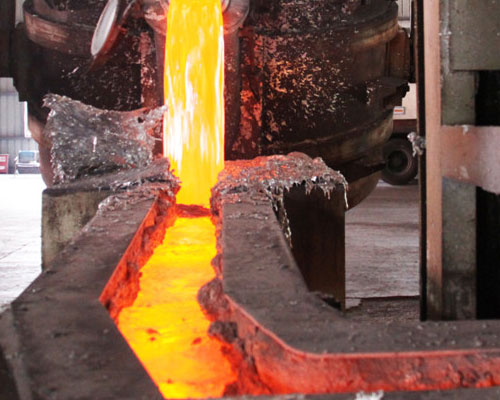At present, users have higher and higher requirements for the surface quality of sheet, strip and foil. In the process of cast-rolling, the longitudinal stripes on the surface of the cast-rolled strip are one of the key factors affecting the surface quality of the finished aluminum foil. Tests have shown that appropriately increasing the pouring temperature of cast-rolling, the height of the front box liquid level, the gap size of the nozzle roll and the distribution structure inside the nozzle can effectively reduce the longitudinal stripes on the surface of the cast-rolled strip and obtain high-quality cast-rolling.
When the slab is erected, the pouring temperature of cast-rolling is too low, and the liquid metal flows slowly in the nozzle cavity and cannot rush through the choke dam in the mouth cavity. This will cause the metal to solidify in the mouth cavity and cause the riser to fail.
When standing the slab, the pouring temperature is low, the liquid metal has poor fluidity in the nozzle cavity, and the metal temperature distribution is uneven, which causes the Fe, Si, Ti and other elements in the molten metal to produce surface segregation of the composition during crystallization. Fe, Si elements The content of the segregation site is significantly increased, and the content of Ti element is significantly reduced. This surface segregation forms structure stripes. It may appear on the upper and lower surfaces of the cast-rolled strip, and the position and width are not necessarily, but there are obvious rules, that is, once it appears, it will appear in the same position without interruption, and continue for several coils until the mouth is removed. And because the pouring temperature is low, very small slags are easily formed in the mouth cavity during the slag removal process, which changes the metal solidification conditions. When the metal liquid solidifies here, it will also produce uneven composition, resulting in The components segregate on the surface and form structural stripes. This is because a very small slag is formed in the mouth cavity, forming a groove on the surface of the newly crystallized cast-rolled sheet. After rolling deformation, the metals on both sides merge together, but fail to weld, thus forming a straight line Stripes. Because it is produced in the casting process, it cannot be eliminated by cold rolling and foil rolling production, and it will eventually be reflected as dark lines and longitudinal stripes in the foil production.

When the slab is erected, the pouring temperature is higher and the fluidity of the metal is increased, so that the metal will pass through the choke dam in the nozzle cavity more smoothly, the temperature field in the entire mouth cavity will be more uniform, the crystal structure will be uniform, the surface segregation will be less, and It is not easy to form small slagging objects in the mouth cavity, and there are few tissue stripes and longitudinal stripes on the surface of the cast-rolled sheet. After the vertical board is out of the board, if there are no organizational stripes and longitudinal stripes, in the entire production process, as long as the process parameters are properly matched, there will be no more organizational stripes and longitudinal stripes. Therefore, after the vertical slab is successful, the pouring temperature can be appropriately lowered to 695 ℃ ~ 705 ℃, so as to prevent other waste products from affecting the quality of the cast-rolled plate during normal casting and rolling production, and at the same time, it can increase the casting-rolling speed and increase the output.
If the pouring temperature of cast-rolling is too high, the melt is easy to inhale and form slag, causing air passages and slag inclusions during casting and rolling. And after the success of the vertical board, there will be defects such as coarse grains and sticky boards, but it will take a long time to reduce the pouring temperature to 695°C to 705°C, and some process waste will be produced. It is generally not recommended that the pouring temperature is too high. Judging from the test results and analysis, the surface quality of process two is better than that of process one.

